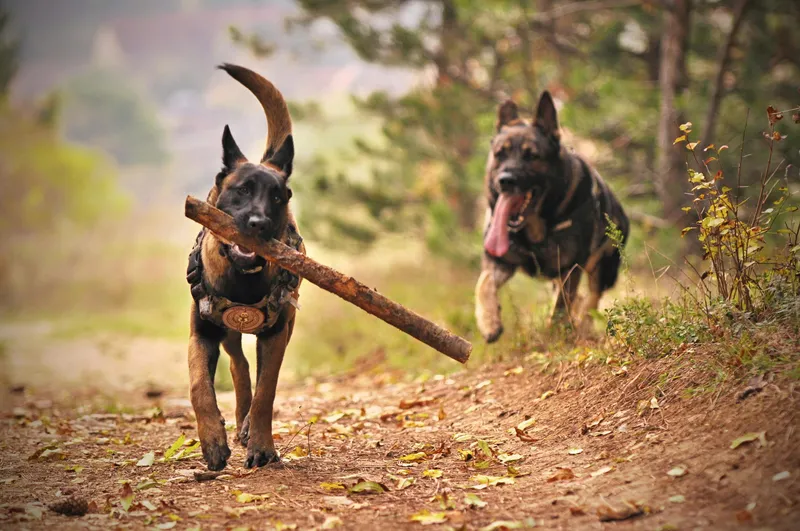The German Shepherd is one of the most recognized and admired dog breeds in the world. Known for their intelligence, versatility, and loyalty, they make ideal companions for both families and service work. In this comprehensive guide, you’ll discover everything about the origin, characteristics, behavior, care, training, and varieties of this extraordinary breed.

Breed Traits & Characteristics
History and Origin of the German Shepherd
Early Documented Traces
While the modern breed dates back to the 19th century, there are records of similar herding dogs from the 7th century in central Europe. These dogs were primarily used to protect and guide livestock.
The Role of Max Von Stephanitz
In 1899, German Captain Max Von Stephanitz officially founded the breed as we know it today. He focused on creating an ideal working dog: strong, intelligent, and obedient.
Foundation of the German Shepherd Club (SV)
Von Stephanitz founded the Verein für Deutsche Schäferhunde (SV), a club that established the formal foundations of the German Shepherd standard. This organization still governs essential aspects of breeding today.
Evolution of the Breed in Modern Times
Over time, the German Shepherd became established as a working dog in multiple areas: military, police, guide dogs for the blind, search and rescue, and companionship. Their reputation grew globally, making them one of the most popular breeds in the world.
Physical Characteristics of the German Shepherd
Size, Weight, and Life Expectancy
This is a large dog, with a weight that ranges between 50-88 pounds. Males typically measure 24-26 inches and females 22-24 inches. Their life expectancy ranges from 9 to 13 years.
Head, Ears, Eyes, and Coat
They possess a strong and proportioned head, erect ears, alert gaze, and a double coat of medium length. Their body is muscular and agile, allowing them to move with great efficiency.
Color Types and Variants
Common colors include black and tan, sable, and solid black. There is also the white German Shepherd variant, less common but recognized in some countries.
Show Lines vs. Working Lines
Show lines tend toward a more marked aesthetic, especially in the back slope. Meanwhile, working lines maintain a more functional morphology designed for performance.

Temperament and Behavior
Intelligence, Obedience, and Adaptability
Considered one of the most intelligent breeds, the German Shepherd learns commands quickly and responds well to positive reinforcement. They are adaptable in both rural and urban situations if provided with sufficient exercise and stimulation.
Behavior with Children and Strangers
They can be protective with children and reserved with strangers. Proper socialization from puppyhood is key to achieving a balanced and confident dog.
Are German Shepherds Dangerous?
They are not dangerous by nature. Their temperament depends on genetics, training, and environment. However, due to their size and strength, they must be handled responsibly.
Functions and Uses of the German Shepherd
Police and Military Dog
Their physical and mental capacity makes them a favorite of police and military forces. They excel in detection tasks, tactical intervention, and security work.
Guide and Service Dog
Many individuals are trained as guide dogs for blind or mobility-impaired people, thanks to their obedience and reliability.
Search and Rescue Work
They perform remarkably in search and rescue operations in disaster areas, avalanches, or earthquakes, being part of specialized K9 units.
Family Companion in Urban Environments
Although they are working dogs, they are also excellent companion dogs if provided with proper exercise, socialization, and attention.
Care, Health, and Life Expectancy

Main Hereditary Diseases
Like many large breeds, they are prone to hip and elbow dysplasia. Diseases such as corneal pannus, Von Willebrand’s disease, and cauda equina syndrome have also been documented.
Importance of Responsible Breeding
Acquiring puppies from responsible breeders is essential. Look for health tests, certifications, and a lineage free of hereditary diseases.
Nutrition, Exercise, and Mental Stimulation
They require a balanced diet rich in protein, along with intense daily exercise and mental challenges. Boredom can lead to destructive behaviors.
Training and Education of the German Shepherd

Early Socialization
From puppyhood, they should be exposed to various people, places, and other animals. This strengthens their development in different environments.
Obedience and Work Training
They learn easily. Basic obedience training should begin from the first months and can evolve toward more complex tasks if desired to train them as working dogs.
Sports like Schutzhund (IPO)
Schutzhund—currently known as IPO—is a sport that evaluates tracking, obedience, and protection. Ideal for German Shepherds with high energy and work motivation.
German Shepherd Variants
Old Line vs. Modern Line
Some enthusiasts distinguish between the old line (straighter, more robust and functional) and the modern line (with more sloped back and oriented toward showing).
The White German Shepherd
An uncommon but highly appreciated aesthetic variant. They are not albino and possess the same qualities as other shepherds, although some clubs don’t accept them in shows.
Curiosities and Cultural Facts
Famous Examples and History in Cinema
Figures like Rin Tin Tin and Strongheart popularized the breed in silent films. Blondi, Adolf Hitler’s dog, was also a German Shepherd, though unfortunately linked to tragic historical events.
Recognition by Canine Associations
The breed is recognized by the FCI, AKC, Kennel Club, and WUSV. These institutions regulate morphological standards and responsible breeding practices.
Is the German Shepherd Right for You?
If you’re looking for a loyal, intelligent, protective, and energetic dog, the German Shepherd might be ideal. However, be prepared to dedicate time, exercise, attention, and training. This is a dog that needs purpose and constant activity.
How to Choose a Responsible Breeder
Before acquiring a puppy, make sure the breeder has:
- Veterinary and genetic certificates
- Early socialization of puppies
- Verifiable reputation
Avoid puppy mills or those without references. The health and stability of your future companion largely depends on their origins.